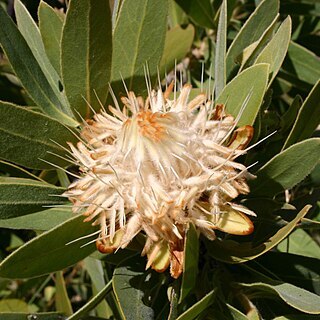Shrub to small bushy tree (0.3-)1-3(-5) m. high.. Young branches brown-tomentose, glabrescent later, the bark dark grey and flaking off to reveal a brown cortex.. Leaves elliptic to narrowly oblanceolate, (6-)8-14(-16) × (1.5-)1.8-4.5(-6) cm., (1.7-)2-5(-6) times as long as broad, rounded or occasionally slightly cuneate at the base, the apex usually rounded to emarginate but occasionally acute in narrower leaves, appressed tomentose when very young, appressed pubescent at maturity or rarely ± completely glabrescent Heads (3-)5-8(-9.5) cm. in diameter, sometimes aggregated into clusters.. Middle bracts (0.8-)1.2-2(-2.7) × (0.5-)0.8-1.7(-2.2) cm., rounded or obtuse, appressed pubescent to tomentose, sometimes glabrescent towards the margins, the hairs grey to rusty-brown, often sericeous; inner bracts 2.5-4.5(-5) × 0.4-1 (-1.2) cm., linear-oblong to linear-spathulate, usually ± equalling the flowers.. Flowers (2.5-)3-4.5(-5.5) cm., white but usually with a brown, orange or pink tinge at tip.. Perianth-base glabrous in the lower part, brown-villous in the upper part; claw brown-villous outside, densely hairy inside; limb (10-)12-15(-20) mm., brown-villous on 3 fused segments but glabrous or shortly pubescent on the fourth.. Style glabrous.. Seed-hairs pale when fresh but darkening with age in herbarium specimens (fide Beard, loc. cit: 176).
Middle bracts (0.8)1.2–2(2.7) and (0.5)0.8–1.7(2.2) cm, rounded or obtuse, appressed-pubescent or-tomentose, sometimes glabrescent towards the margins, the hairs grey to rusty-brown, often sericeous, the surface usually greenish; inner bracts 2.5–4.5(5) × 0.4–1(1.2) cm, linear-oblong to linear-spathulate, usually about equalling the flowers, usually greenish-white with a brownish tip.
Leaves (6)8–14(16) × (1.5)1.8–4.5(6) cm, (1.7)2–5(6) times as long as broad, elliptic to narrowly oblanceolate, rounded or occasionally slightly cuneate at the base, the apex usually rounded to emarginate but sometimes acute in narrower leaves, appressed-tomentose when very young, appressed pubescent at maturity or rarely completely glabrescent.
Multistemmed shrub or small tree, up to 1.5 m high, tending to produce multiple flowerheads. Involucral bracts sparsely to densely sericeous with whitish to rusty brown indumentum. Perianth with limbs very densely hirsute with cream to rusty brown indumentum.
Perianth base glabrous in the lower part, brown villous in the upper part; claw brown villous outside, densely hairy inside; limb (10)12–15(20) mm long, brown villous on the 3 fused segments, the fourth segment glabrous or shortly pubescent.
Young branches brown tomentose, glabrescent later, the bark dark grey and flaking off to reveal a brown cortex.
Flowers (2.5)3–4.5(5.5) cm long, white, usually with a brown, orange or pink tinge.
Heads (3)5–8(9.5) cm diameter, sometimes aggregated into dense clusters.
Shrub to small bushy tree (0.3)1–3(5) m high.
Style glabrous.


